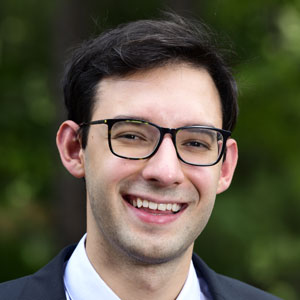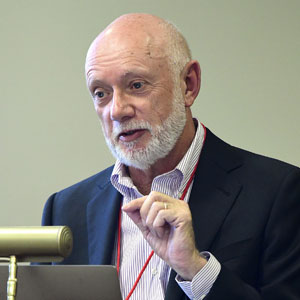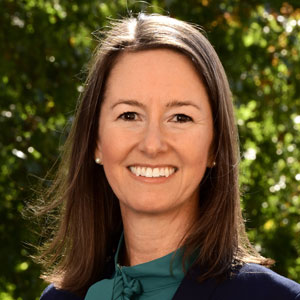Advances in neurotoxicology, research into the developmental origins of health and disease, and numerous presentations by NIEHS scientists and grant recipients were among the many highlights at this year’s Society of Toxicology (SOT) conference.
The 62nd Annual SOT Meeting and ToxExpo was held in Nashville, Tennessee, March 19-23. More than 90 institute scientists, trainees, and staff shared scientific innovations at the event, which drew more than 5,000 attendees from the U.S. and around the world.
Enhancing disease diagnosis
The potential for new discoveries involving liquid biomarkers was the focus of this year’s Hot Topic Session titled “Circulating Molecular and Cell-Derived Biomarkers for Translational Toxicology.” Scientists may one day be able to monitor or diagnose chronic diseases such as cancer through those biomarkers, which are detectable in body fluids. Called liquid biomarkers, they can reduce reliance on hard-to-reach tissue biopsies.
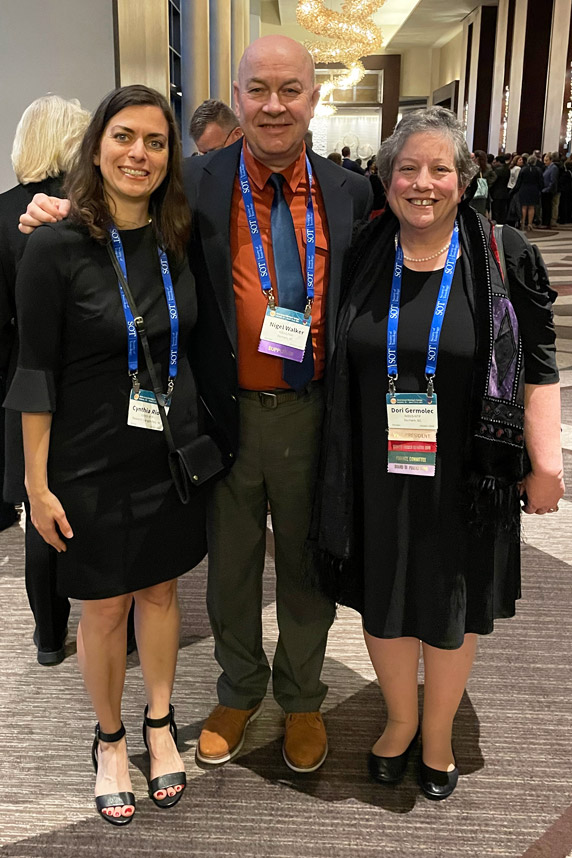
Erik Tokar, Ph.D., staff scientist in the NIEHS Division of Translational Toxicology (DTT) Mechanistic Toxicology Branch, co-hosted the session, and Julie Foley, health scientist in the same branch, among others, presented research on the topic. Foley highlighted how the combination of liquid biomarker identification and other innovative scientific methods, such as multi-omics, continue to move forward efforts in translational toxicology and precision environmental health.
“The NIEHS-led Hot Topic Session demonstrates that we are at the forefront of scientific research and that we are developing important applications,” said SOT Vice President Dori Germolec, Ph.D. She is an immunotoxicologist in the DTT Systems Toxicology Branch.
New approaches to identify hazards
Germolec and others in DTT are working on new approach methodologies (NAMs), which were a major topic at the conference. NAMs are strategies and technologies, such as artificial intelligence and cell-based models, that complement the use of experimental animals. They are being applied to a broad range of areas, such as prioritizing emerging chemicals of concern and understanding disease susceptibility in diverse populations.
Helena Hogberg-Durdock, Ph.D., a staff scientist in the NTP Interagency Center for the Evaluation of Alternative Toxicological Methods (NICEATM) and an expert in developmental neurotoxicity, presented several posters and continuing education sessions where she explained the real-world application of NAMs.
- “Organophosphorus Flame Retardants: A Case Study on the Use of IATA for DNT to Prioritize a Class of Compounds.”
- “PM10: In Vitro to In Vivo Extrapolation Strategy and Guidance Across Organ System Toxicities.”
- “Shedding Light on Population Variability and Susceptibility: New Approach Methods to Inform Risk Assessment”

NAMs can help scientists translate and understand what effects chemical exposures may have on different organs in a human-relevant situation.
“We could use this approach to prioritize a class of chemicals, for example, and based on the information we get from a battery of in vitro assays, we can select which are the more concerning chemicals to investigate further,” Hogberg-Durdock explained.
Other presentations included the following.
- “Applications of Class-Based Approaches in Risk Assessment and Toxicological Research,” by Kamel Mansouri, Ph.D., a staff scientist and computational chemist in NICEATM. Mansouri’s ongoing research in chemical grouping and classification and predictive computational models continue to have broad reach.
- Kristin Eccles, Ph.D., a visiting fellow in the Systems Toxicology Branch, presented “Mapping a Path to Disease: Quantifying the Risk of Exposure to Environmental Chemical Mixtures via a Common Molecular Target Using a Geospatial Modeling Approach.”
- Brian Silver, Ph.D., Kevin Gerrish, Ph.D., and Tokar presented a poster titled “Cell-free DNA Derived from Cardiac Organoids as a Potential Indicator of Toxicity and Tissue-Level Events.”
Tokar and Anna Kreutz, Ph.D., a postdoctoral fellow in the DTT Mechanistic Toxicology Branch, presented a poster describing their work on developmental neurotoxicity studies using NAMs. Specifically, they used human stem cells to identify environmental toxicants that affect the development and expression of dopamine. Another poster presentation on the topic of NAMs and developmental neurotoxicity was “Tiered testing of Arsenic Developmental Neurotoxicity using Neural Organoid and 2D in vitro Models,” presented by visiting fellow, Xian Wu, Ph.D., Darlene Dixon, D.V.M., Ph.D., a group leader in the Molecular Pathogenesis Group; and Tokar.
Developmental origins of disease
A symposium titled “The Importance of the Placenta in Toxicological Studies” was chaired by Thaddeus Schug, Ph.D., health scientist administrator in the NIEHS Population Health Branch. He noted that research into the placenta is key to advancing the scientific framework known as Development Origins of Health and Disease.
The placenta performs many vital roles during development and can provide critical information about the health of the baby and mom, according to Schug. For example, insights into environmental exposures, nutrition, and prenatal health and development can be gained by studying the placenta. Researchers can study the placenta to learn more about health outcomes in both mothers and children. Several NIEHS scientists and grantees presented during the session.
- “Phthalate Exposure and Longitudinal Ultrasound Measures of Placental Function: The Human Placenta and Phthalates Study” — Research led by Kelly Ferguson, Ph.D., head of the NIEHS Perinatal and Early Life Epidemiology Group; presentation by Ferguson’s trainee Emma Rosen, from the University of North Carolina at Chapel Hill.
- “Placental Glucose Transfer After Gestational Particulate Matter Exposure” — NIEHS grantee Phoebe Stapleton, Ph.D., from Rutgers University.
- “Legacy and Replacement Per- and Polyfluoroalkyl Substances (PFAS) Target the Placenta” — Suzanne Fenton, Ph.D., DTT scientist.
- “Single Cell and Cell Type Specific Analyses in Human Placental Tissues: Implications for Chemical Exposures and Adverse Birth Outcomes” — Kelly Bakulski, Ph.D., University of Michigan.
- “Placental Transcriptomic Alterations Underlie Neurodevelopmental Effects of Pesticide Exposure” — Carmen Marsit, Ph.D., Emory University.
Schug noted that NIEHS participates in the Human Placenta Project, an effort led by the Eunice Kennedy Shriver National Institute of Child Health and Human Development. The goal is to expand knowledge about placental development, function, and structure.
Neurotoxicity
Neurotoxicity is always a big topic at SOT. This year, one presentation focused on the origins of neurological disease and the neural exposome, delivered by Chief of the Genes, Environment, and Health Branch Cindy Lawler, Ph.D. And a neurotoxicity battery for botanicals was discussed by Mechanistic Toxicology Branch Staff Scientist Chris McPherson, Ph.D.
A large-scale collaboration called The CIAO Project, which includes more than 80 scientists and 50 organizations worldwide, was featured during the conference. The group’s latest research regarding the acute and chronic neurotoxicity effects of COVID-19 was shared with attendees.
The blood-brain barrier, for example, should be considered when examining neurological symptoms, together with the sequence of other biological events following viral exposure, explained Hogberg-Durdock. She said that doing so will help scientists understand how an exposure leads to cell damage and then to organ-level effects that result in a noticeable adverse outcome, such as loss of smell, for example. The research framework that assesses that sequence of events is referred to as an adverse outcome pathway.
“We are examining what is happening at the cellular, organ, organism, and population level in COVID-19 and have developed four of these adverse outcome pathways for neurological symptoms — loss of smell, encephalitis, seizures/epilepsy, and stroke. Then, we explored the modulating factors.”
Those factors can include personal demographics such as age but could also be socioeconomic disadvantage or living in polluted communities.
“The susceptibility piece is important because we all are different, and we each will respond differently to exposures,” Hogberg-Durdock said. “Some people are more vulnerable to adverse outcomes than others due to comorbidities or co-exposures.”
The CIAO Project will continue to explore the key susceptibilities related to COVID exposures and various outcomes across life-stages, she noted.
International reach
Another international effort highlighted at SOT was the joint SOT and Japanese Society of Toxicology (JSOT) Symposium. Germolec hosted this year’s session titled “Novel Insights into Mechanisms of Chemical Carcinogenesis: From Chemical Screening to Tumor Ecosystem Effects.”
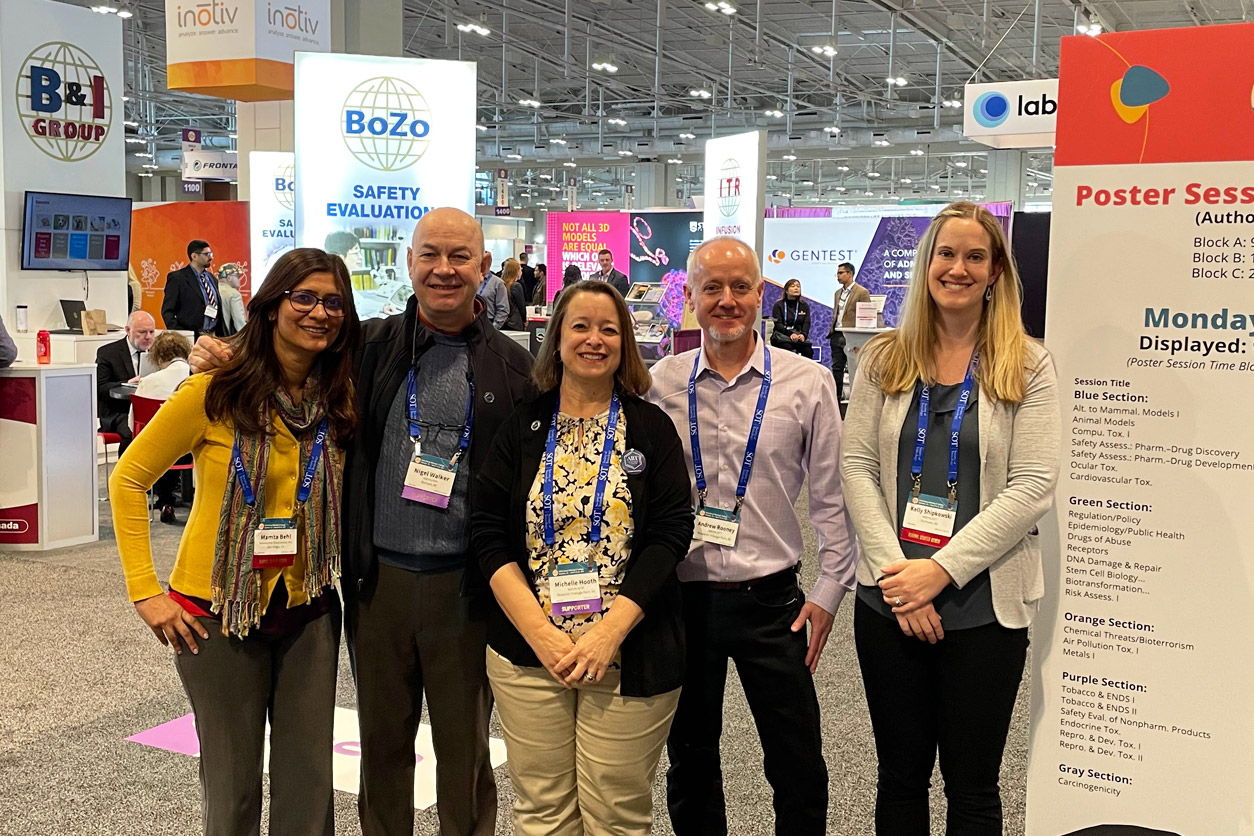
“We hold two joint symposiums every year,” Germolec said. “There is one in the U.S., and then one at the JSOT’s annual meeting, which this year will be in Yokohama, Japan. We take turns deciding on the topic, and two researchers from SOT and two from JSOT are invited to participate on the panel.”
This year’s JSOT will focus on immunotoxicology, and Germolec was invited to present at the conference. The other U.S. invitee is NIEHS grantee Natalie Johnson, Ph.D., from Texas A&M University.
Also, to serve more international audiences, several editors from Environmental Health Perspectives were at the meeting to recruit editors for the soon-to-be-relaunched Journal of Health and Pollution, which will focus on research conducted in low- and middle-income countries.
Leading into the future
NIEHS and National Toxicology Program (NTP) Director Rick Woychik, Ph.D., participated in a featured session titled “Meet the Directors” alongside leaders from the U.S. Environmental Protection Agency and the U.S. Food and Drug Administration.

Woychik also offered opening remarks for an exhibitor-hosted session to discuss the Interagency Coordinating Committee on the Validation of Alternative Methods (ICCVAM) Strategic Roadmap. Discussions on wrapping up the former five-year plan and receiving public comment for progressing forward were among the highlights. Efforts to advance NAMs and establish greater scientific confidence in them were also discussed.

“I am excited about the robust discussion with our many stakeholders on progress ICCVAM has made in implementing the strategic roadmap and how we can tackle the many challenges that lie ahead,” said Nicole Kleinstreuer, Ph.D., director of NICEATM.
NICEATM also launched an updated version of the Integrated Chemical Environment (ICE) dashboard and held several well-attended demonstrations and tutorials for conference attendees at the NIEHS exhibit.
In addition, Woychik, U.S. Food and Drug Administration (FDA) Chief Scientist Namandje Bumpus, Ph.D., and Nigel Walker, Ph.D., chief of the DTT Systems Toxicology Branch, made remarks at an NTP exhibitor-hosted session. They discussed current efforts that are enhancing the interagency partnership and coordination of research activities.
During that session, attended by a standing-room-only crowd, NIEHS Deputy Director Trevor Archer, Ph.D., who also serves as interim DTT Scientific Director, and Bumpus responded to questions about the future of environmental justice within toxicology. They also shared how NIEHS and FDA are looking at diversity, equity, inclusion, and accessibility in the workforce and in regard to work products, including greater transparency in clinical trials and making data more available.
NIEHS program officers and grant administrators hosted several workshops and shared research funding information, and the Office of Communications and Public Liaison hosted the NIEHS booth at the ToxExpo.
“We are really happy to be nearly back to pre-pandemic levels in terms of registrants and attendees, and in terms of scientific programming,” said Germolec. “It was very exciting to see everyone in person in Nashville.”
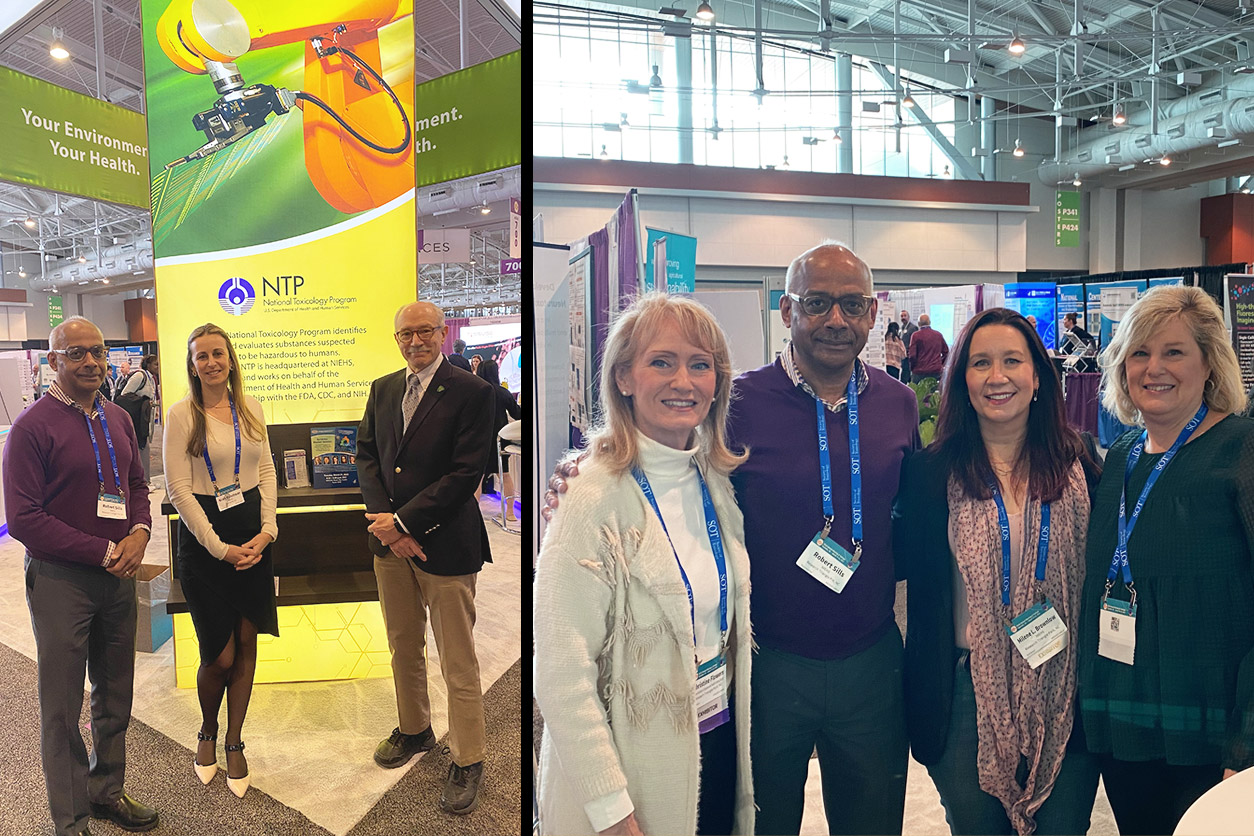
Citation: Hogberg HT, Lam A, Ohayon E, Shahbaz MA, Clerbaux LA, Bal-Price A, Coecke S, Concha R, De Bernardi F, Edrosa E, Hargreaves AJ, Kanninen KM, Munoz A, Pistollato F, Saravanan S, Garcia-Reyero N, Wittwehr C, Sachana M. 2022. The adverse outcome pathway framework applied to neurological symptoms of COVID-19. Cells, 11(21):3411.





